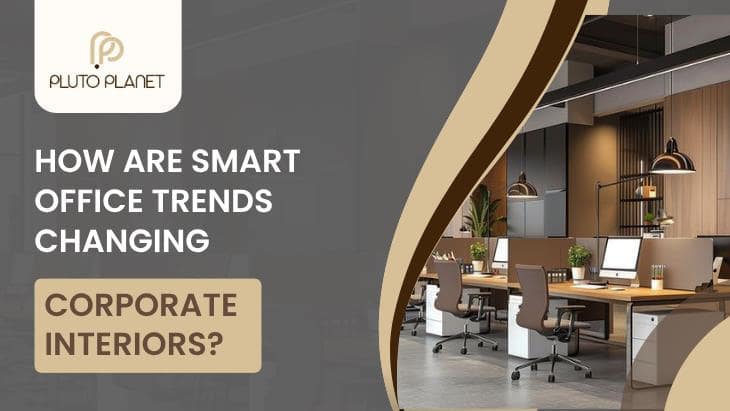The trends regarded as smart office are the incorporation of hi-tech features that automate, simplify, and transform the workplace. From intelligent lighting systems to AI-controlled meeting rooms, the modern office environment has transformed to become digitally connected.
The need to be agile and efficient in the workplace has led to the increased need to have technology-driven workplaces. Employees require offices that would help in collaboration, comfort and flexibility, and companies require answers that would enhance productivity and help in cost reduction. This is where the smart office interior design is critical.
The digital transformation is also transforming corporate interiors with a dislike of traditional layouts in favor of connected, responsive and adaptable designs. Offices are not fixed anymore; they are dynamic due to data, automation, and employee requirements.
Getting to know about Smart Office Concepts
A smart office refers to an office that has been improved with technology to allow efficiency, productivity, and an easy user experience. It is based on connectivity and automation.
1. The main elements of Smart Office include:
• IoT (Internet of Things): Smart devices connected to one another, e.g. smart thermostats, lighting systems, and sensors.
• Automation: Automated systems, such as lights that are switched on when a room is empty.
• Artificial Intelligence (AI): The tools that forecast behavior and suggest how to improve it or optimize resources.
• Sensors: Occupancy, temperature, air quality and others are tracked by their devices.
• Integrated Systems: Unified systems where all building technologies are managed in real time.
Smart offices apply data-driven information to manage the workspace better. Having been used to predict room usage to maximize energy use, data will be useful in designing efficient and friendly work environments.
Corporate Interiors: The Evolution
Interiors in corporations have also changed drastically. In the past, offices were fixed, hierarchical and static. They have been converted to versatile and interactive places today by the aid of technology.
Major Office Transformation Changes:
• Traditional to Tech-Enabled: Offices have become digitalized, making smart screens, wireless systems, and automated controls a thing.
• Influence of Hybrid Work: As employees divide their time both at home and in the office, the interior design should provide the opportunity to work remotely and offer flexible workstations.
• Superiority on Flexibility: Flexible furniture, multifunctional areas, and mobile screens enable spaces to be applicable to various areas.
• Attention to Customization: Intelligent systems will allow employees to adjust lighting, heating, and office furniture.
• Comfort of employees: It is now a consideration to include wellness-related issues such as natural lighting, ergonomic systems, and better air quality.
This development is a greater change to the human-oriented modern office design that is triggered by technology.
Top Smart Office Fashion Trends Changing Corporate Interiors
A. IoT-Enabled Workspaces
Office interior design has been transformed by IoT in that devices are able to communicate and automate tasks. Smart lighting can be adjusted according to the daylight, occupancy sensors when the areas are not in use, and auto climate control systems that help to maintain optimal temperatures.
These systems boost:
• Energy efficiency
• Cost savings
• Employee comfort
The smart offices can save about 30 percent of energy, which makes them sustainable and cost-effective.
B. AI and Office Operation Automation
AI introduces some intelligence and automation in the daily work, and it allows employees to concentrate on more valuable work.
AI increases the efficiency of offices by:
• Resource scheduling which is automated and books meeting rooms based on their availability.
• Intelligent conference rooms that automatically install light, temperature and screens.
• Voice assistants that organize reminders, workflow tasks and queries.
Automation also minimizes human error and saves a lot of time in the day-to-day operations.
C. Contactless and Touchless Technologies
Touchless technologies now form the basis of hygiene and safety post-pandemic.
Examples include:
• Smart access control (face recognition, biometrics)
• Automated doors
• Touch-free elevators
• Visitor registering using QR code.
Convenience and minimization of contamination risks: these additions make offices more convenient and minimize the risk of contamination, which is a critical consideration in offices nowadays.
D. Smart Collaboration Tools
Teamwork is the fundamental aspect of an effective team. Smart offices are designed with sophisticated technology that allows smooth communication, face-to-face and remotely.
The use of important collaboration tools involves:
• Digital whiteboards
• Interactive displays
• Video conferencing systems
• Project management dashboards are available in the file project management dashboards.xls.
These tools render hybrid teamwork non-punishing and keep everyone in touch.
E. Space Optimization Based on Data
A sensor and a management platform give real-time information on the use of the workspace.
Companies can track:
• Occupancy patterns
• Peak usage hours
• Underutilized areas
This allows them to:
• Reconfigure layouts
• Enhance the allocation of resources.
• Reduce wasted space
Office interior design gets more effective and strategic with data-driven decisions.
F. Flexible/modular interior design
The intelligent office is more about flexibility. Modern designs use:
• Modular furniture
• Movable walls
• Foldable desks
• Multi-functional areas
Flexible interiors are facilitating brainstorming, individual work, group meetings, and relaxation all within one space. This is the trend that fully fits the hybrid working models.
Effect on Employee Experience
The contemporary workplaces should be able to provide comfort, well being and engagement to the employees. Smart office tendencies significantly improve all three.
Improvements include:
• Customized workstations (light, temperature, desk height)
• Smart air system will improve air quality.
• Mood and productivity enhancement through simulated natural lighting.
• Smarter acoustic solutions to reduced noise levels.
• Ergonomic, comfortable furniture.
When staff members are made to feel appreciated and encouraged, they become very productive and satisfied.
Benefits for Corporations
There are numerous benefits of adopting smart office trends:
1. Improved Operational Productivity
Automated systems save on human labor and improve on precision.
2. Cost Reduction
Green solutions and cost-effective space utilization reduce costs of operation.
3. Sustainability
Intelligent systems save on energy, which would make the company environmentally friendly.
4. Stronger Brand Image
An office that is technologically empowered and up-to-date impresses clients and attracts the best talent.
5. Future-Readiness
Smart offices can be modified with new technologies and work trends.
These advantages render the introduction of the modern office design technology as a smart investment of any progressive firm.
Implementation Problems with Smart Office Trends
Smart offices have numerous benefits, but they have problems as well:
1. High Initial Investment
The smart technologies may be costly in the short run, but in the long term they save money.
2. Data Privacy Concerns
Office sensors and data systems should be safe so that user data is secured.
3. Employee Training
It might be necessary to train the staff to operate using new tools.
4. System Integration
Various platforms and devices should have an efficient interconnection.
In spite of such issues, the use of smart offices is still growing, since the advantages outnumber the restrictions.
Smart Corporate Interiors Future
Office interior design will become even smarter and more immersive in the future.
Upcoming trends include:
1. Office design in the metaverse
Virtual simulations will guide companies to visualize office layouts and make amendments prior to implementation.
2. Predictive Environments
AI will also be able to predict the needs of employees—turn on the light, reserve a room, alert, and so on.
3. Advanced Automation
Even in the future offices, robotic assistants will automatize more tasks, including self-cleaning workstations.
4. Environmentally Friendly Materials and Artificial Intelligence Energy Regulation
Smart energy grids will turn offices into greener places, and the materials will be environmentally friendly.
The future will be a combination of technology, sustainability and human-oriented design.
Conclusion
The smart office trends are changing the corporate interiors in an environment that incorporates technology, data, and design to come up with an intelligent, efficient and employee-friendly environment. With the shift to hybrid work and the digital transformation of business, a modern design of an office should be adaptable, interconnected and future-oriented. Smart offices can help make working conditions better and enhance both operational efficiency and sustainability as well as long-term growth.
We are PlutoPlanet and we manage to build future-ready workplaces that are technologically advanced, innovative, and well thought out.
Contact PlutoPlanet and turn your office into a smart, modern and high-performing place.
Top 5 FAQs
1. What is a smart office?
A smart office uses technology like IoT, sensors, and AI to improve efficiency, comfort, and workspace management.
2. How does smart office design improve productivity?
It automates tasks, enhances comfort, improves collaboration, and reduces distractions.
3. Are smart offices expensive to implement?
Initial costs can be high, but energy savings, efficiency, and better space utilization provide long-term benefits.
4. Can smart office features be added to an existing office?
Yes, many features like smart lighting, sensors, and AI tools can be integrated into current interiors.
5. What is the biggest advantage of modern office design?
It creates a flexible, efficient, and employee-focused environment that adapts to future workplace needs.









Leave a reply